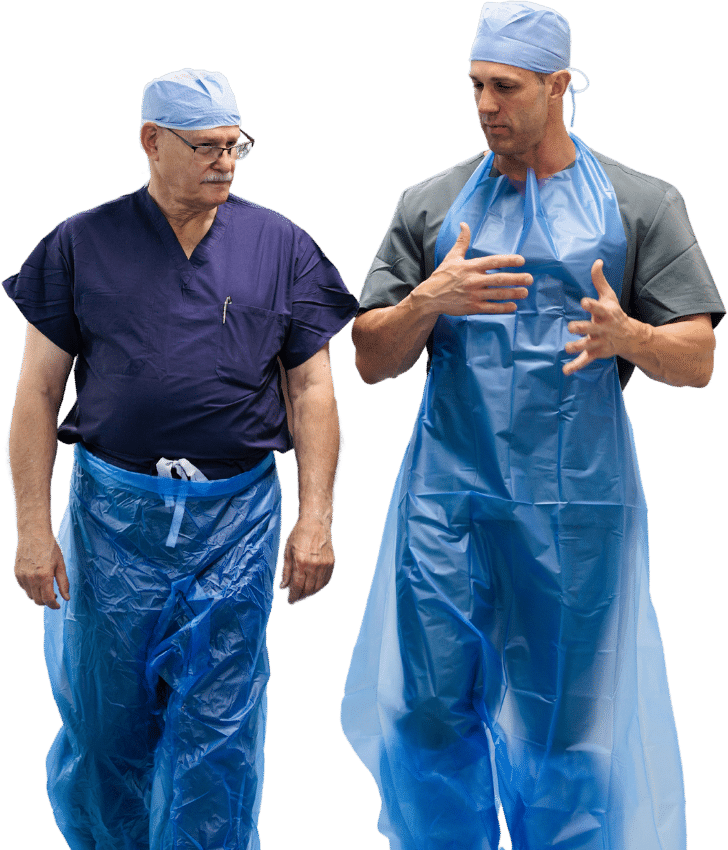Scrubs are a staple in the medical community. And as our uniform of choice and necessity, scrubs serve a variety of valuable functions.
- Protection against healthcare-associated infections (HAIs). Scrubs are made of fabrics that are easy to clean and disinfect, which helps to prevent the spread of infections and diseases in healthcare settings.
- Easy identification. The different colors of scrubs worn by different medical professionals help patients and staff to easily identify who is who. This is especially important in busy healthcare settings where there are many people moving around.
- Comfort and range of movement. Scrubs are designed to be comfortable and allow for a wide range of movement. This is important for medical professionals who are often on their feet for long periods of time and who need to be able to move freely to care for patients.
- Functionality. Scrubs often have pockets (we love pockets!) for storing medical supplies, which is helpful for medical professionals who need to have their hands free.
- Personal expression. Scrubs are available in a variety of colors, patterns, and styles, which allow medical professionals who have some dress-code flexibility to express their personal style.
In this blog, we’ll give you a rundown of how to protect and preserve your medical scrubs so they serve you well for as long as possible.
Why take proper care of your medical scrubs?
Taking proper care of your medical scrubs is essential for several reasons.
1. Save $$$
Replacing scrubs can be costly, and by prolonging their lifespan through proper care, you can save money in the long run.
2. Look the Part
Clean and well-maintained scrubs contribute to a professional appearance, which is crucial for healthcare professionals.
3. Use as Directed
Medical scrubs serve as an important form of personal protective equipment (PPE). Ensuring their integrity through proper care helps maintain their effectiveness in preventing the spread of drug-resistant bacteria, fungi, and other germs and infections.
How to take proper care of your scrubs.
Taking good care of your medical scrubs is essential for checking all of the above boxes. So, how do you go about doing it?
- Mindful washing and stain treatment based on material and type of fluid interaction (not all gross stuff is treated equally).
- Proper folding and storage (we’ve all jammed our scrubs in a locker or tossed our extra pair of scrubs in the backseat).
- Use of quality PPE to stop ick before it happens (raise your hand if the cheap stuff left you soaked after surgery).
By paying a little extra attention to these three key activities, you’ll ensure your medical uniform looks the part while providing proper protection. All without breaking the bank.
Now, let’s get into more of the “standard operating procedures” of each activity.
Washing and stain treating your scrubs.
Knowing the material of your medical scrubs is important for proper care and maintenance. The fabric composition determines the appropriate washing temperature, detergent, and stain treatment methods.
By following the correct washing and care instructions, you’ll ensure your scrubs remain clean, stain-free, and in good condition for extended use. Here’s a guide on how to properly wash and care for your medical scrubs:
How to wash cotton or cotton/polyester blend medical scrubs.
When it comes to washing cotton medical scrubs, it’s important to use the right settings and products to ensure they remain clean and in good condition.
Scrubs in the wash:
- Use the regular wash cycle on your washing machine.
- Wash the scrubs separately to avoid spreading the grossness or color transfer.
- Use warm water rather than hot water to prevent the scrubs from shrinking.
- Avoid using cold water as it may not effectively remove stubborn stains.
- Use a regular detergent that is suitable for cotton fabrics.
- If the scrubs are heavily stained or soiled, consider using a heavy-duty laundry detergent.
Scrubs in the dryer:
- Use a low heat setting in the dryer to minimize shrinkage and damage to the fabric.
- Avoid using dryer sheets or fabric softener, as they can leave residue on the scrubs.
Keep in mind that following proper washing instructions helps prevent the spread of germs and infections among healthcare professionals.
How to treat different types of stains on your medical scrubs.
Treating all sorts of stains on medical scrubs is a lot like treating your patients, it’s important to know what you’re dealing with before treatment. Most often, you know the culprit. And here are some of the most common stains nurses, surgeons, and other medical professionals run into and how to best treat them.
Blood Stains and Bodily Fluid Stains:
- Rinse the stain in cold water as soon as possible to remove any solid matter.
- Pre-treat the stain with a stain remover or liquid dish soap.
- Wash the scrub in the hottest water recommended on the care label using a heavy-duty laundry detergent.
White vinegar alternative for blood stains and bodily fluid stains:
Soak the stained area in a solution of 1 part white vinegar to 2 parts cold water for 30 minutes. Then, wash the scrubs as usual.
Medication, Food, and Drink Stains:
- Blot the stain with a clean cloth or disposable spoon to remove any excess substance.
- Pre-treat the stain with a color-safe stain remover or liquid dish soap.
- Wash the scrub in warm water using a regular detergent.
White vinegar alternative for medication, food, and drink stains:
Blot up as much of the stain as possible with a clean cloth. Mix 1 part white vinegar with 2 parts water. Apply the solution to the stain and let it sit for 30 minutes. Then, wash the scrubs as usual.
Chemical Stains:
- Follow the instructions provided by your facility for handling chemical spills on scrubs.
- Rinse the stain immediately with cold water to remove any residue.
- Pre-treat the stain with a phenolic disinfectant or natural disinfectant.
- Wash the scrub in the hottest water recommended on the care label using a heavy-duty laundry detergent.
White vinegar alternative for chemical stains:
Mix 1 part white vinegar with 2 parts water. Apply the solution to the stain and let it sit for 30 minutes. Then, wash the scrubs as usual.
Oil-Based Stains and Grease Stains:
- Blot the stain with a clean cloth or disposable spoon to remove any excess oil or grease.
- Apply a small amount of liquid dish soap to the stain and gently rub it in.
- Wash the scrub in the hottest water recommended on the care label using a heavy-duty detergent.
Baking soda alternative for oil-based and grease stains:
Sprinkle the stain with baking soda. Let the baking soda sit for 30 minutes, then brush it off. Mix 1 part white vinegar with 2 parts water. Apply the solution to the stain and let it sit for 30 minutes. Then, wash the scrubs as usual.
Ink Stains:
- Place a clean cloth or paper towel underneath the stained area to prevent the ink from spreading.
- Blot the stain with a cloth soaked in rubbing alcohol or hydrogen peroxide.
- Wash the scrub in warm water using a regular detergent.
Rubbing alcohol alternative for ink stains:
Apply a small amount of rubbing alcohol to a cotton ball. Blot the stain with the cotton ball until it is gone. Then, wash the scrubs as usual.
Overarching tips for treating stains on your medical scrubs.
Washing and drying scrubs:
Remember to always check the care label on your scrubs before treating any stains and follow the instructions for washing and drying. By treating stains promptly and using the appropriate stain removers, you can keep your medical scrubs looking clean and professional.
Treating stains on scrubs:
Any type of vinegar can be used to treat stains on scrubs, but white vinegar is the most effective. White vinegar is a mild acid that can break down the bonds that hold stains in place. It is also a natural disinfectant, so it can help to kill bacteria and germs on the scrubs.
Here are some additional tips for treating stains on scrubs with vinegar:
- Act quickly. The sooner you treat a stain, the easier it will be to remove.
- Blot, don’t rub. Rubbing can spread the stain and make it harder to remove.
- Test the stain treatment on an inconspicuous area first. This will help to make sure that it doesn’t damage the fabric.
With a little care and attention, you can easily remove stains from your scrubs with vinegar.
The role of quality PPE for medical scrub care.
Personal protective equipment (PPE) cannot be underestimated when it comes to taking proper care of your medical scrubs. High-quality PPE not only ensures the safety and well-being of healthcare professionals, but it also plays a significant role in maintaining the longevity and cleanliness of your scrubs.
Sloan Medical’s founder, Stewart Sloan, knows this firsthand. During his surgical years, he threw away his fair share of soaked/stained scrubs that fell victim to underperforming PPE. Frustrated by the subpar PPE available to him at the time, he took matters into his own hands and developed his own PPE line that now serves medical professionals nationwide — helping prevent the spread of HAIs and keeping scrubs looking good for as long as possible.
Sloan Medical is here to help you take care of the scrubs that care for you.
By following these simple tips and using high-quality PPE, you can ensure that your scrubs remain in top condition, allowing you to focus on what matters most — providing exceptional care to your patients.If you have not had the chance to try out Sloan Medical PPE to protect you, your patients, and your scrubs, get your free samples now. We like nothing more than to prove our value while providing the best PPE product for colleagues in the medical field.





